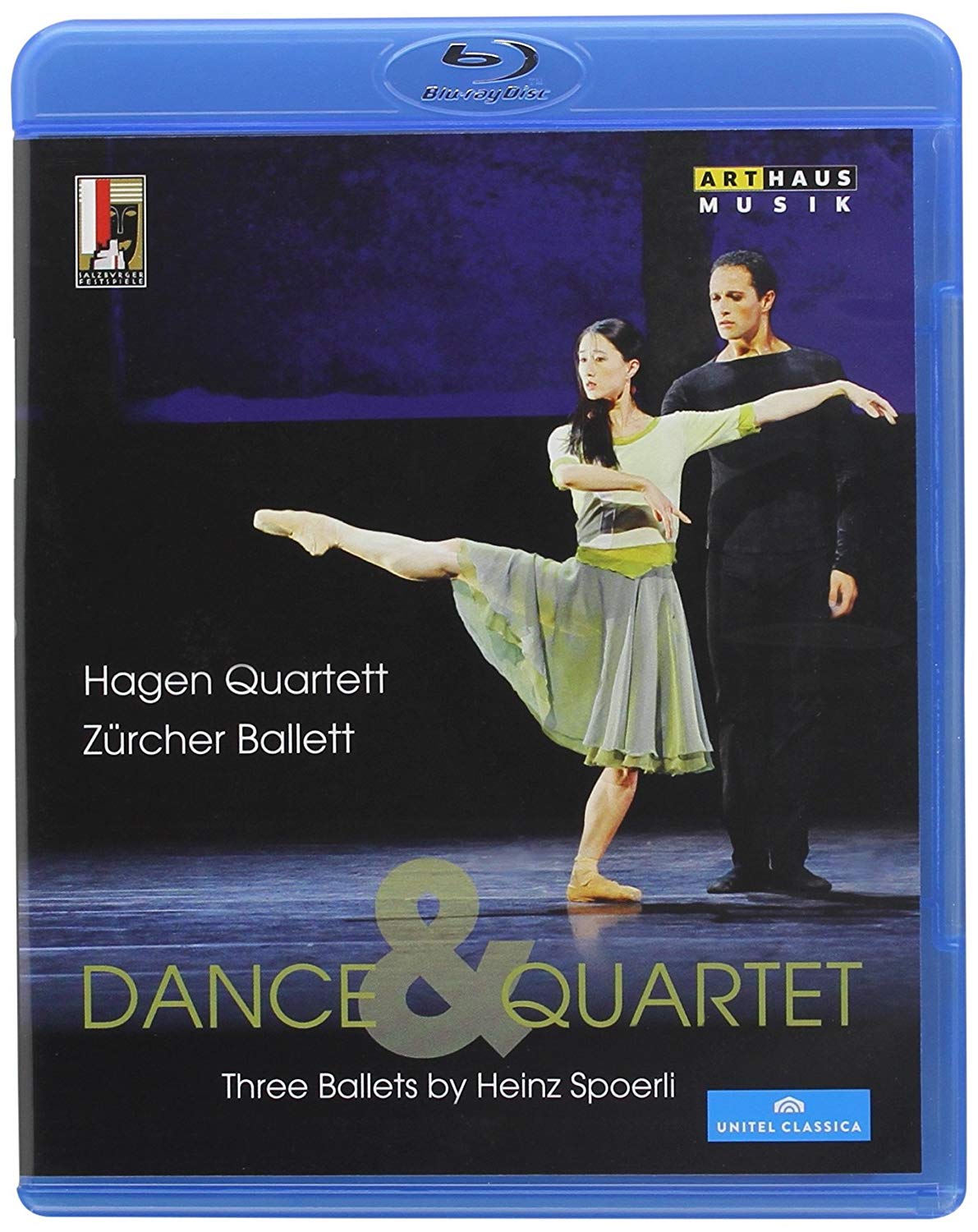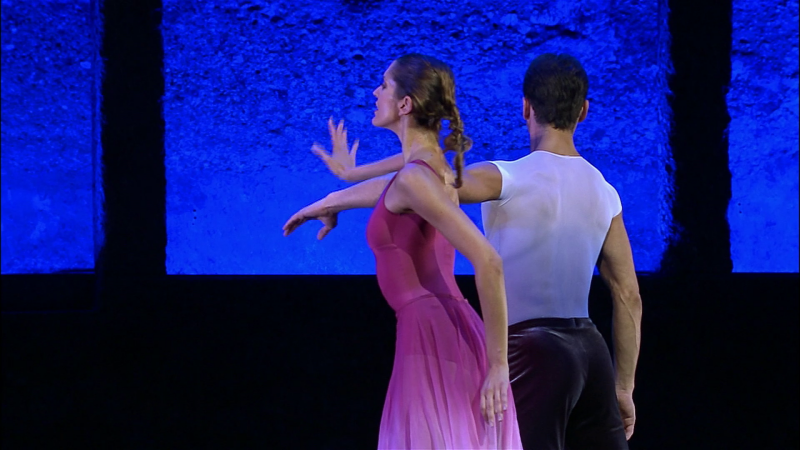

Dance & Quartet triple bill of short ballets choreographed in recent years by Heinz Spoerli and performed 2012 at the Salzburg Festival (at the Felsenreitschule):
Lettres intimes. Music is Janáček String Quartet No. 2 ("Intimate Letters"). Cast of 13 stars Seh Yun Kim (Zürcher Ballett) and Arsen Mehrabyan (Royal Swedish Ballet) backed up by 5 women and 6 men from the Zürcher Ballett.
In Spillville. Music is Dvořák String Quartet in F Major ("American"). Cast of 11: stars Sarah-Jane Brodbeck (Zürcher Ballett) and Tigran Mikayelyan (Bayerisches Staatsballett) backed up by 4 women and 5 men from the Zürcher Ballett.
Der Tod und das Mädchen. Music is Schubert String Quartet in D minor ('Death and the Maiden"). Cast of 12: stars Yen Han (Zürcher Ballett) and Arsen Mehrabyan backed up by 5 women and 5 men from the Zürcher Ballett.
The music is performed by the Hagen Quartet with Lukas Hagen (1st violin), Ranier Schmidt (2d violin), Veronika Hagen (viola), and Clemens Hagen (cello). Dancers from the Zürcher Ballett (other than the named stars) are Artur Babajanyan, Mélanie Borel, Juliette Brunner, Ty Gurfein, Chris Jensen, Viktorina Kapitonova, Oleksandr Kirichenko, Sergiy Kirichenko, Samantha Mednick, Galina Mihaylova, Kyla Moore, Daniel Mulligan, Boris Myasnikov, Filipe Portugal, Flavia Salamanka, and Hasan Topcouglu. Set design by Florian Etti; costumes designed by Nelly van de Velden, Heinz Spoerli, and Florian Etti; lighting by Martin Gebhardt. Directed for TV by Agnes Méth. Released 2013, disc has 5.1 dts-HD Master Audio sound. Grade: B-
The first time I watched this, I had the curious feeling that things had been thrown together for this title. Although Spoerli had a total of 21 dancers available, the largest number of to appear in one number was 13. Surely the Zürcher Ballett is a lot bigger than that and doesn't need to bring in 2 men stars from other companies to appear at nearby Salzburg. Although the dancers were good, they did not seem to be all that well drilled. Why were the costumes so simple and the stage design so dinky-looking? And even though her video content was fine, why was Agnes Méth having so much trouble with motion artifacts and those horrible wires that ruined most of her high-angle shots? Why would a ballet company do a program of nothing but string quartets? And why did Spoerli himself take a curtain call for this rather modest effort?
I hit the Internet. The Hagan Quartet is probably on everybody's list of the top 20 string quartets in the world. They happen to live in Salzburg and are local favorites. Spoerli might have the longest dance-making résumé in the world. Macht nichts. For all the usual good bureaucratic reasons, Spoerli was obliged to give up his post at the Zürcher Ballett just a few weeks before the 2012 Salzburg Festival. Then I stumbled into a 2012 story (quoted now in part) from Intermezzo, a delightful blog that follows the Salzburg scene:
“Dance is not a core element of the Salzburg Festival, but new Intendant Alexander Pereira's old buddy Heinz Spoerli stepped down as head of the Zurich Opera Ballet last month. And what better way to mark a retirement at the age of 72 than to spend weeks working like a dog producing three one act ballets that will only be seen twice?
Plopped in the orchestra pit, the Hagen Quartet provided particularly distinguished musical accompaniment.
None of the choreography was groundbreaking or particularly virtuosic, but equally, nothing outstayed its welcome, and the Hagen Quartet on their own were worth the price of admission.”
So subject title was, I think, thrown together as Spoerli's way of putting everybody on notice that he's not about to quit making dances. (Arthaus confirms in the keepcase booklet some key facts reported by Intermezzo.)
The world premiere of Lettres intimes was in 2009, the WP for Der Tod und das Mädchen was in 2010, and the WP for In Spillville was in 2011. At Salzburg this triple feature was seen by perhaps 3000 persons at the Felsenreitschule. So if you buy Dance & Quartet, you are seeing works that have only been viewed live by a tiny number of ballet fans. And watching this is a completely different experience than seeing, for example, the Royal Opera House HDVD of Alice's Adventures in Wonderland with it's massive production values and everybody performing to virtual perfection. What we see in Dance & Quartet is raw and real: the dancers can brag they were at Salzburg, the Hagen folks try an experiment, and Spoerli gets to gloat: "We pulled it off."
Lettres intimes:
Janáček String Quartet No. 2 starts off acerbic and spiky, but it soon turns lyrical. Here's my interpretation of the dancing; your version will be different and better. We start with an Alpha male (Arsen Mehrabyan) who is filled with anguish and foreboding:
He passion is for Alphette (Seh Yun Kim). But there is some sort of deep impediment:
Alpha resists all temptations and advice:
He and Alphette are reconciled several times:
The men and women pair up, leaving the Alphas on their own. This scene with the corps in unison is refreshing after watching so individual dancing. But it seemed a bit ragged to me. I think the pairs got out of sync here and that two of the men have their heads turned the wrong way:
The tension mounts:
H'm. Did Spoerli call for this to happen?
Our hero's fears are realized as Alphette decamps:
Spillville:
The humorous title is just the name of a town in America where Dvořák stayed writing sunny, dressed-up folk songs for the string quartet. The cheerful dancing matches the music throughout with no cloud in the sky:
Here Tigran Mikayelyan undoes Sarah-Jane Brodbeck's bun. Never saw this move before:
Well, that's the silliest-looking pigtail. Better let the girls stay with their buns:
From a distance, I thought these girls might be twins:
No clouds in the sky, but too many wires. The closer high-angle shots pick up 2 wires and the longer-range shots have 3. I think you have to abandon any angle that has this kind of defect. Maybe I'm too picky.
Der Tod und das Mädchen:
Schubert's Der Tod und das Mädchen is one of the crown jewels of the string quartet literature. Music scholars, poets, and even theologians try to plumb its drama. Trying to make a dance to illustrate this music is a bit like an actor who takes on the stage role of Jesus Christ: no matter how great you do, you're still going to be flop. So how well does Spoerli do with this self-inflicted mission impossible? Pretty well, I think. First we see some village life with the beautiful girls and youths:
Death feels lonely; he sizes up all the prospects:
Death contends with the young men:
And picks the most innocent girl to seduce. The next 3 screenshots are from a long, transcendent pas de deux to the second movement of the quartet (andante con moto). This is the slow movement that was inspired by Schubert's famous Lied set to words of the poem Der Tod und das Mädchen:
The slow movement is followed by a frantic tarantella, or dance of death, in the last movement:
A few more words about the Hagen Quartet. They gave a terrific and well-recorded performance that greatly boosts the value of this disc. But they are in a dark pit, and you don't see them play more than a few seconds.
Could the producer of a show like this arrange to have the musicians perform the music separately with lights up and add this to the title as a separate feature? Then the title of the record might be something like Dance and/or Quartet. As pressed, this title is a reasonable value as a dance recording; let's hope they make a profit. But if correctly photographed performances of the Hagen Quartet had been added also, this disc could have become an irrespirable best-seller. The Blu-ray disc has the capacity to present wonderful value to consumers with only modest increments in cost to the producers. But the thinking of folks who are producing and selling our fine-arts HDVDs is still mired in business models developed for LPs, CDs, and DVDs. Conclusion: missed opportunity.
Now for a grade. With the strong music from the Hagen Quartet, I think this title starts off with a solid B. But I'll mark this down to a B- for the soft spots discussed. Every time I watch this, I like it better. But if you are used to magnificent production values with your ballets, you might want to skip this one.
OR

























